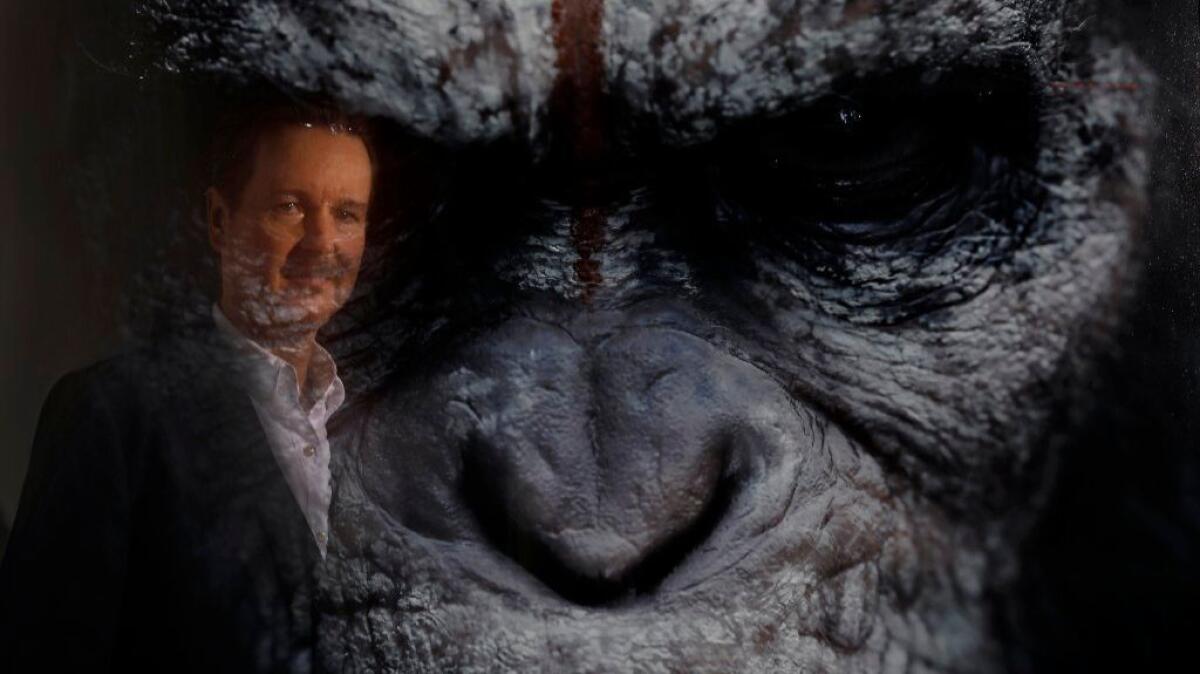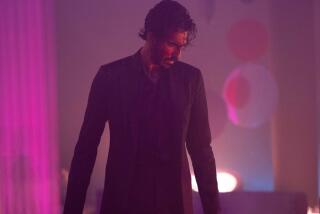‘Apes’ director Matt Reeves: I wanted to push ... Caesar’s story into the realm of the mythic’

When he was 8 years old, Matt Reeves started making 8-millimeter movies inspired by his love for the original “Planet of the Apes.” “I’d have my friends put on gorilla masks and run around shooting these little sci-fi films,” he recalls. “As a kid, I was captivated by these images of horses with apes on them.” Decades later, Reeves, perched on a sofa in his tidy Hollywood office, has taken his fascination with primate cinema to a whole new level as the auteur behind the 2014 performance-capture blockbuster “Dawn of the Planet of the Apes” and this summer’s “War for the Planet of the Apes.”
Taking the reins from “Rise of the Planet of the Apes” director Rupert Wyatt, Reeves, lauded for his low-budget horror hit “Cloverfield,” initially harbored reservations about helming Twentieth Century Fox’s multimillion-dollar franchise. “I’d avoided doing tent-pole pictures because I assumed the studio would let you make some small percentage of what you want and a much larger percentage of what they want,” he says. “But if I don’t have a way into a story on a personal level, then I literally don’t know where to place the camera.”
WATCH: Video Q&A’s from this season’s hottest contenders
Reeves made both “Apes” sequels his way. For “Dawn,” he connected with Andy Serkis’ performance as language-acquiring ape Caesar by observing similar behavior in his then-infant son. “My little boy was just learning how to speak when I saw ‘Rise,’” Reeves recalls. “The way Andy played Caesar as this animal coming into articulation, it was the same thing with my son. When he finally spoke, it was with great urgency.”
After “Dawn” raked in $711 million worldwide, Reeves and co-writer Mark Bomback scripted “War” as the ultimate test for Caesar, forced to face a murderous desire for revenge after his family’s been killed by humans. They added new nemesis the Colonel (Woody Harrelson), quirky sidekick Bad Ape (Steve Zahn) and deaf girl Nova, played by Amiah Miller, who auditioned for the part by improvising scenes with casting director Debra Zane in the role of an ape.
Reeves and his team also expanded the movie’s visual scale, filming in British Columbia with the Alexa 65 large format camera rig. “I wanted to push the final chapter of Caesar’s story into the realm of the mythic so it almost becomes like this Darwinian biblical epic,” says Reeves, who studied Akira Kurosawa action films, David Lean’s 70mm masterpieces and, especially, “Once Upon a Time in the West.” “I was very affected by the way Sergio Leone alternated wide shots with these super-tight close-ups,” Reeves says. “I wanted to make ‘War’ more classical, almost like a western. On one level, the spectacle has to do with seeing our characters being dwarfed by the landscape, which I find very moving.”
While the human actors he directed in “War” would ultimately be translated into ape characters through an elaborate visual effects pipeline, Reeves felt remarkably unencumbered by technology on set. “Shooting motion-capture outside, on natural locations, the first step for me was, in a way, like directing an indie movie,” he says. “I could change anything on the day. I could walk up to Andy and ask him, ‘Where does it feel like you should stand?’ Each step after that involved technical passes and this army of animators, but everything on ‘War’ was driven by creating a scene with actors. That’s what I love the most about making movies.”
It’s about creating empathy. For me, that’s what cinema is all about.
— Matt Reeves
Reeves spent about a year in “War for the Planet of the Apes” post-production. “I basically made two movies,” he says. “I’d spend the first half of the day editing the movie with actors walking around in their mo-cap suits. The second half of the day, we’d be communicating with Weta Digital in New Zealand until 1 in the morning to make sure the animation honored the emotions in the performance. We’d look at the lighting, the hair, the skin, the moisture simulation — does it look real? That was intense.”
Reeves’ “War” makes use of tech tricks to challenge “us-versus-them” thinking. “We want audiences to emotionally identify with these creatures,” he says. “As a storyteller, you want to provoke an audience to look at themselves by extending their sympathies to characters who are unlike themselves. It’s about creating empathy ... that’s what cinema is all about.”
See the most read stories this hour »
More to Read
From the Oscars to the Emmys.
Get the Envelope newsletter for exclusive awards season coverage, behind-the-scenes stories from the Envelope podcast and columnist Glenn Whipp’s must-read analysis.
You may occasionally receive promotional content from the Los Angeles Times.






